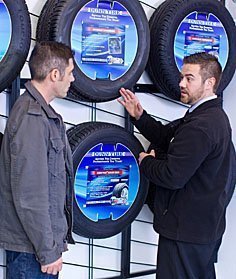 As everyone in the Northeast can attest to – this has been a
brutally long and cold winter. As the snow finally begins to
disappear and temperatures slowly start to rise, the annual
question arises: is it time to remove my winter tires?
As everyone in the Northeast can attest to – this has been a
brutally long and cold winter. As the snow finally begins to
disappear and temperatures slowly start to rise, the annual
question arises: is it time to remove my winter tires?
According to Silvana Aceto of the Canadian Automobile Association (CAA) in south-central Ontario, it’s best to wait until temperatures are consistently above 44°F (7°C) before trading winter tires for all-seasons. Keep an eye on the weather forecast in your area. Once the snow has melted and the days warm up consistently into the low to mid 40s°F, you are ready to switch back to your all-season tires.
Generally in the northeast, early April is a good time to take the winter tires off and get the all-seasons back on.
While it’s certainly possible that we may experience snowfall or other wintry conditions even after spring seems to have made its debut, you don’t want to wait too long to remove winter tires. We occasionally see some early spring days get into the 70s°F. Winter tires are made of softer rubber which simply does not perform as well on warm or hot pavement. In fact, the rubber tends to become very soft on a hot day and your winter tires will wear out quickly. Softer tires also create more drag and road resistance. This added friction requires more power to move the vehicle – thereby reducing gas mileage.
If Dunn Tire is storing your all-season tires, we recommend you call ahead so the store can ensure your tires are out of storage and at the store waiting for you. If you have any questions about tire performance or the best time to make the seasonal tire switch, please contact us.
Remember to be mindful of the other issues that can crop up at this time of year. Potholes continue to be a problem and hitting them can cause significant damage to various parts of your car, including your tires, alignment, and suspension. When the snow melts, you can see – and avoid – them better, but a spring snowfall can obscure them and make it much harder for you to steer clear of these hazards. In addition, daily temperature changes can make the roads a little more unpredictable and drivers need to maintain constant vigilance to avoid problems. The roads may be a little icy for the morning commute, wet with the warmer afternoon temperatures, and very icy as the temperature drops again at night. Stay informed!
